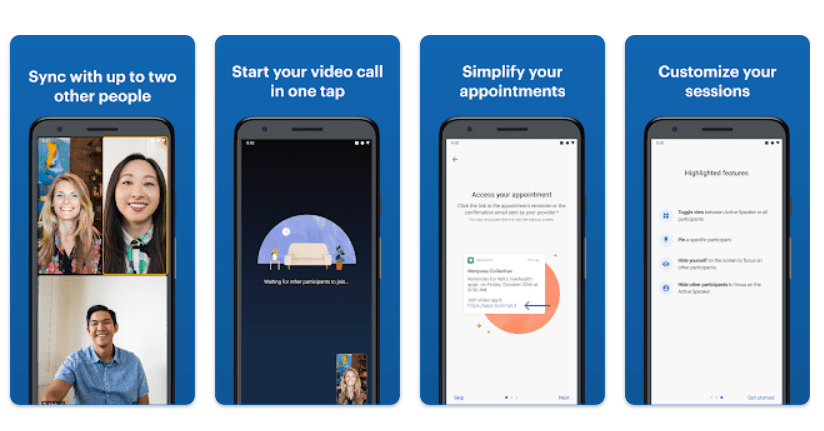Smartphones have changed the way people interact with healthcare services, and in 2023 over 116 million received online doctor consultations compared to 98 million in 2021.

Unsurprisingly, the global telehealth market is expected to grow to $432 billion by 2032.
Where there’s money to be made, hustlers will come, and so we’ve analyzed top apps in 2024 to produce a guide on how you can build your own app in the telemedicine space.
Overview of Telemedicine Apps
Telemedicine apps offer a platform for virtual consultations, remote monitoring, and patient management.

Telehealth apps serve various healthcare needs, including:
- Remote Consultations: Patients can consult with doctors via video or chat.
- Appointment Scheduling: Users can schedule appointments and receive reminders.
- E-Prescriptions: Healthcare providers can send prescriptions electronically.
- Health Monitoring: Patients can track their health metrics through the app.
Telemedicine not only increases accessibility to healthcare services but also improves the efficiency of medical practice management.
Essential Features of a Telemedicine App
A successful telemedicine app should include several essential features to enhance the user experience and meet healthcare standards. Here’s a breakdown of the features needed in a telehealth apps:
1. Patient Features
- User Registration and Profile Management: Users can create accounts and manage their profiles.
- Appointment Booking: A user-friendly interface to schedule appointments with healthcare providers.
- Video Conferencing: Secure video calls for consultations.
- Chat Functionality: Instant messaging for quick communication.
- E-Prescriptions: Ability to receive and manage prescriptions electronically.
- Payment Gateway Integration: Secure payment processing for consultations and services.
2. Healthcare Provider Features
- Doctor Registration and Profile Management: Healthcare professionals can create and manage their profiles.
- Appointment Management: Ability to manage appointments and patient consultations.
- Patient History Access: Providers can access patient medical history and records.
- Chat and Video Communication: Tools for seamless communication with patients.
- Prescription Management: Facilities to create and send prescriptions.
3. Administrative Features
- User Management: Admins can manage users (patients and providers) within the app.
- Analytics and Reporting: Tools to analyze app usage and patient engagement.
- Compliance and Security Management: Features to ensure regulatory compliance and data security.
Steps to Develop a Telemedicine App
Building a telemedicine app involves a series of strategic steps:
- Market Research: Identify your target audience and their needs, then analyze competitors and their offerings.
- Define App Features: Outline the core and additional features based on user needs.
- Monetization Model: Subscriptions, pay-per-consultation, or freemium models.
- Design the User Interface (UI): Create UI/UX catering to patients and providers.
- Select the Tech Stack: Choose suitable technologies for frontend, backend, and database management.
- Develop the App: Use agile methodologies for iterative development and testing.
- Test the App: Conduct thorough testing for usability, functionality, and security.
- Launch the App: Deploy the app on platforms like Android and iOS.
- Post-Launch Support: Provide support and updates based on user feedback.
Regulatory and Compliance Requirements
Developing a telemedicine app requires adherence to specific regulations to ensure patient safety and data protection.

Key compliances needed in telemedicine apps include:
- HIPAA Compliance (USA): Ensures the privacy and security of patient information.
- GDPR Compliance (EU): Protects personal data and privacy for individuals in the EU.
- Local Healthcare Regulations: Understand the regulations specific to the regions where your app will operate.
| Regulation | Description | Region |
| HIPAA | Protects patient information confidentiality | USA |
| GDPR | Regulates data protection and privacy for EU citizens | EU |
| Telemedicine Laws | State-specific laws regarding telehealth practices | USA |
| MHR (My Health Record) | Australian digital health record system | Australia |
Technology Stack and Tools Required to Build a Telemedicine App
Choosing the right technology stack is crucial for the success of your telemedicine app. Here’s a breakdown of the recommended tools:
| Category | Technologies / Tools |
| Frontend Development | Frameworks: React Native, FlutterLanguages: JavaScript, Dart |
| Backend Development | Frameworks: Node.js, DjangoLanguages: JavaScript, Python |
| Database Management | Databases: MongoDB, PostgreSQLCloud Services: AWS, Google Cloud |
| Communication APIs | Video Conferencing: Zoom API, Twilio, AgoraMessaging: Firebase Cloud Messaging, Twilio |
| Security Tools | Encryption: SSL/TLSAuthentication: OAuth, JWT |
Conclusion
The rise of telemedicine such as Telehealth by SimplePractice, Healow, and Teladoc showcased distinctive features that cater to diverse healthcare needs.

Developing a telemedicine app requires careful planning, a clear understanding of user needs, and adherence to regulatory standards.
By following the outlined steps and incorporating essential features, you can create a successful telehealth app that meets the needs of patients and healthcare providers alike.
If you’re looking to build a mobile application, check out our portfolio of past projects and contact us if you like what you see. Also, consider joining our mailing list for a one-stop resource on everything from micro-SaaS validation all the way to execution and promotion. Get a nifty list of questions to ask app developers when you sign up!
App Developer Interview Questions Template
Download this template now so you know exactly what to ask App Development Agencies! Let us know where should we send it through the form below.



